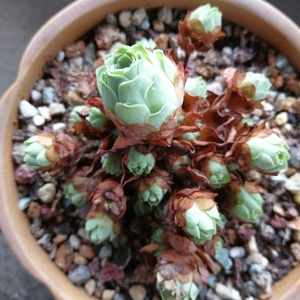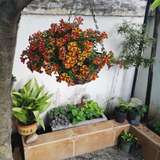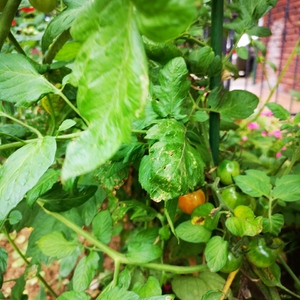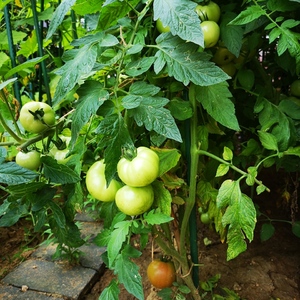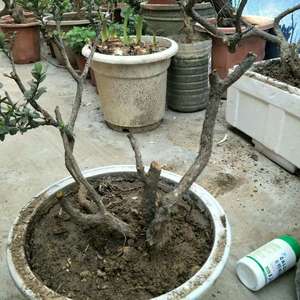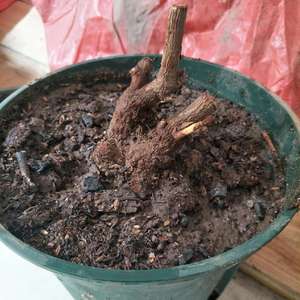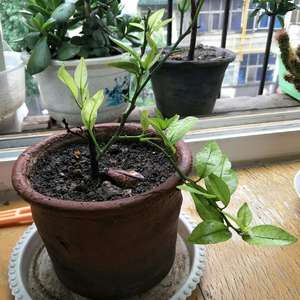文章
Miss Chen
2018年07月16日

Fast-growing annual vines with yellow blooms up to 5 inches across, loofah plants (Luffa spp.) usually require a four-month growing season to produce mature gourds. Therefore, gardeners in the north may need to start them indoors about 4 to 6 weeks before the last spring frost. During the summer and early autumn, the heavy vines should be grown in humus-rich soil in full sun, preferably on a sturdy trellis or fence to keep their 1 to 2-foot gourds off the ground. Those fruits must be harvested before or just after the first autumn frost and are used both as bath sponges and dish scrubbers.

Pick and Peel Mature Sponges
If you live in an area with a long growing season, Jack Arnott of Cobb County Extension Service recommends that you allow your loofah gourds to dry on the vine until their skin is brown and brittle and you hear seeds rattle when you shake those gourds. Break open the skin at the blossom the end opposite the stem of the gourd to reach those seeds, if you wish to save them. It usually is easy to pick off the rest of the brittle skin with your fingers to reveal the sponge beneath. If you prefer, you can dunk the gourds in a bucket of water instead -- for any time period lasting from 5 minutes to several days -- and peel off their skins in wet strips.
Pick and Peel Immature Sponges
If your growing season isn't quite long enough, Jeanine Davis of North Carolina State University Cooperative Extension reports that you can harvest adequate sponges from gourds which have only partially yellowed, as long as their skins are beginning to slip. After you make an opening to save the seeds, grab the end of one of the fibers running the length of the gourd's ridges and pull on it to unzip the remaining skin.
Clean and Dry Sponges
Immediately plunge a less-than-mature sponge into a bucket of water to wash out any juices that remain due to its only half-dry condition. Although the sponge still will be white at that stage, it's a good idea to soak it in a bleach solution to eliminate fungi and bacteria. Mature sponges also should be immersed in bleach solution, of 4 tablespoons of bleach per 1 gallon of water, both to kill contaminants and to brighten their naturally off-white color.

After disinfecting the sponges, rinse them with clean water and spread them in the sun to dry. A porous surface works well for this purpose. You can turn screens into drying tables by laying them horizontally on top of sawhorses.

Pick and Peel Mature Sponges
If you live in an area with a long growing season, Jack Arnott of Cobb County Extension Service recommends that you allow your loofah gourds to dry on the vine until their skin is brown and brittle and you hear seeds rattle when you shake those gourds. Break open the skin at the blossom the end opposite the stem of the gourd to reach those seeds, if you wish to save them. It usually is easy to pick off the rest of the brittle skin with your fingers to reveal the sponge beneath. If you prefer, you can dunk the gourds in a bucket of water instead -- for any time period lasting from 5 minutes to several days -- and peel off their skins in wet strips.
Pick and Peel Immature Sponges
If your growing season isn't quite long enough, Jeanine Davis of North Carolina State University Cooperative Extension reports that you can harvest adequate sponges from gourds which have only partially yellowed, as long as their skins are beginning to slip. After you make an opening to save the seeds, grab the end of one of the fibers running the length of the gourd's ridges and pull on it to unzip the remaining skin.
Clean and Dry Sponges
Immediately plunge a less-than-mature sponge into a bucket of water to wash out any juices that remain due to its only half-dry condition. Although the sponge still will be white at that stage, it's a good idea to soak it in a bleach solution to eliminate fungi and bacteria. Mature sponges also should be immersed in bleach solution, of 4 tablespoons of bleach per 1 gallon of water, both to kill contaminants and to brighten their naturally off-white color.

After disinfecting the sponges, rinse them with clean water and spread them in the sun to dry. A porous surface works well for this purpose. You can turn screens into drying tables by laying them horizontally on top of sawhorses.
0
0
求助
Khim_ali
2018年07月16日

Im new to propagating succulents and its day 5 but the plant didnt go well. I wait till a pedal falls off or I take the bottom ones and twist it to get them off. I tried drying it in my house for 2-3 days on top of soil with some sunlight by the window but the plant began to rot and get all soft/mushy so I tried doing it outside drying them for 2-3 days then misting them with water but my plant has turned black can someone gove me tips on propagating ive been trying but its not going well. Also when propagating is it norml for the plant to get soft and mushy?

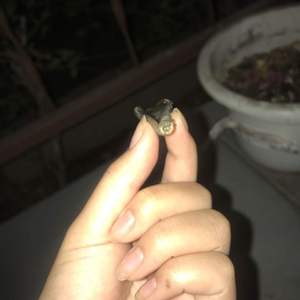


0
0
Khim_ali:@Liz Lynch okay I’ll give t a few more days , thank you!!
Liz Lynch:Give it a few more days.... but when you say soft - how soft? Softness usually means to much water 😊
Liz Lynch:I reckon this still may have potential to go
文章
Miss Chen
2018年07月05日

Green beans are a popular vegetable for the home garden. They grow quickly and require only sun and water. Pole varieties grow between 5 and 10 feet high, according to Cornell University, and require staking. Bush beans are compact and need no support.

Time Frame
Bean seeds germinate within 8 to 10 days under optimal conditions. They emerge as a tiny hooked stem with one single lobe and perhaps a cracked seed coat. Within a few days, the first real leaves emerge. Green beans are harvested within 60 to 75 days, depending on the variety. Dried bean varieties may take as long as three or four months to mature, according to Purdue University.
Considerations
Bean seeds germinate best when soil temperatures are between 70 and 80 degrees Fahrenheit. They are slow to germinate when soil temperatures are below 60 F. They are not at all frost hardy, and are planted outdoors when daytime temperatures are above 75 F. They don't transplant well.

Warning
Bean seeds are damaged by soaking in water or by being planted in very wet soil. Plant them in warm, moist, but not soggy, soil at a depth of 1 inch beneath the surface.

Time Frame
Bean seeds germinate within 8 to 10 days under optimal conditions. They emerge as a tiny hooked stem with one single lobe and perhaps a cracked seed coat. Within a few days, the first real leaves emerge. Green beans are harvested within 60 to 75 days, depending on the variety. Dried bean varieties may take as long as three or four months to mature, according to Purdue University.
Considerations
Bean seeds germinate best when soil temperatures are between 70 and 80 degrees Fahrenheit. They are slow to germinate when soil temperatures are below 60 F. They are not at all frost hardy, and are planted outdoors when daytime temperatures are above 75 F. They don't transplant well.

Warning
Bean seeds are damaged by soaking in water or by being planted in very wet soil. Plant them in warm, moist, but not soggy, soil at a depth of 1 inch beneath the surface.
0
0
求助
💫sammie💫
2018年06月30日

Why are my golden sedum's leaves wrinkling like this? i water it every 5 days and take it outside to get sun for most of the day, i live in zone 8. am i overwatering, underwatering, or am i giving it too much sun? i'm still relatively new when it comes to plant care, and id appreciate help from anyone.

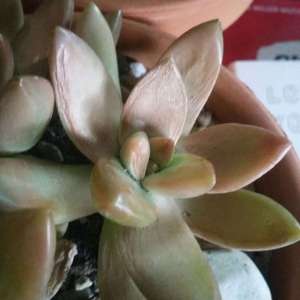


0
0
shirly mei:To me they look like you have been overwatering them. Make sure that you use cactus soil and only water them when the soil is completely dry. I leave my golden sedum all day outside too and I water them maybe every 2 weeks
Fion:Maybe the roots aren't growing.
meriunkat:succulents only need 6 hours of sunlight
WHdeckgardener:hi, hard to say...I have had success using good draining soil...cactus if possible. they like sun..or indirect sun. once established I only watered when the pot felt light. then good drink.
文章
Miss Chen
2018年06月29日

Spike of FlowerheadsDescription: This perennial plant is 2-5' tall and unbranched. The central stem is light green to purplish green, terete or slightly ridged, and glabrous to sparsely pubescent. The alternate leaves are up to 10" long and about 1/3" (8 mm.) across, becoming smaller as they ascend the stem. Because of their dense distribution, they appear almost whorled. The leaves are linear in shape and their margins are smooth (entire). Each leaf has a distinct central vein. Both the upper and lower leaf surfaces are light to medium green and glabrous to sparsely hairy. The central stem terminates in a wand-like spike of flowerheads about 4-18" in length. These flowerheads are densely crowded along the spike, facing in all directions; they bloom at the top of the spike first, opening later below. Each flowerhead is about 1/3" (8 mm.) across, consisting of 4-10 disk florets and no ray florets. The corolla of each disk floret is pink to purplish pink (rarely white) and narrowly tubular. The upper corolla divides in 5 small lobes that are lanceolate in shape and somewhat recurved. A deeply divided style is strongly exerted from the corolla; it is white to light pink, filiform, and sometimes slightly twisted or curved. Around the base of each flowerhead, there are appressed floral bracts (phyllaries) that are overlapping. These floral bracts are green to purple, glabrous, and oval in shape. The blooming period occurs from mid- to late summer, lasting about 3 weeks. There is no noticeable floral scent. Afterwards, the florets are replaced by small achenes with stiff bristles at their apices; these bristles are light brown. The root system consists of a corm with shallow fibrous roots. Colonies of plants are often formed by means of clonal offsets that involve the production of new corms.
Cultivation: The preference is full sun, moist conditions, and sandy loam. Other soil types, such as loam and gravelly loam, are readily tolerated in cultivation. The soil should possess sufficient organic material to retain moisture. The height of this plant can vary considerably, depending on its maturity, soil moisture, and soil fertility. During hot dry weather, the lower leaves may wither away, otherwise this plant presents few problems.
Range & Habitat: The native Marsh Blazingstar occurs in NE Illinois and a few scattered counties elsewhere (see Distribution Map). It is an uncommon plant in the wild. Habitats include moist black soil prairies, moist sand prairies, prairie swales, edges of marshes and bogs, grassy fens, calcareous seeps, moist alkaline sandflats, and areas along railroads. This blazingstar is found primarily in higher quality natural areas, especially where it is sandy.

Faunal Associations: The flowerheads are cross-pollinated by bumblebees, long-horned bees (Melissodes spp.), leaf-cutting bees (Megachile spp.), butterflies, and skippers. These insects suck nectar, although some of the bees also collect pollen for their larvae. Two uncommon prairie insects feed on Liatris spp. (blazingstars): caterpillars of Schinia sanguinea (Liatris Flower Moth) feed on the florets and developing seeds, while caterpillars of Carmenta anthracipennis (Liatris Borer Moth) bore through the stems. Mammalian herbivores eat this and other blazingstars readily; groundhogs and rabbits favor younger plants, while deer and livestock are more likely to browse on mature plants. The corms are eaten by the Prairie Vole and Meadow Vole. An overpopulation of these animals can make the establishment of this plant difficult in some areas.
Photographic Location: The photographs were taken at a moist prairie in Meadowbrook Park, Urbana, Illinois.

Comments: Marsh Blazingstar is a very attractive plant while in bloom, resembling a magic wand. It is more common in flower gardens than in the wild, although some cultivated plants may be hybrids with similar species. Among the various Liatris spp. (blazingstars) that are native to Illinois, Prairie Blazingstar (Liatris pycnostachya) probably resembles Marsh Blazingstar the most. However, this latter plant has floral bracts (phyllaries) that are strongly recurved, while the floral bracts of Marsh Blazingstar are appressed together and relatively smooth. Other blazingstars within the state are either shorter in height or they have larger flowerheads with more disk florets per head. While other blazingstars are typically found in mesic prairies and various upland habitats, Marsh Blazingstar is unusual in its preference for wetter habitats.
Cultivation: The preference is full sun, moist conditions, and sandy loam. Other soil types, such as loam and gravelly loam, are readily tolerated in cultivation. The soil should possess sufficient organic material to retain moisture. The height of this plant can vary considerably, depending on its maturity, soil moisture, and soil fertility. During hot dry weather, the lower leaves may wither away, otherwise this plant presents few problems.
Range & Habitat: The native Marsh Blazingstar occurs in NE Illinois and a few scattered counties elsewhere (see Distribution Map). It is an uncommon plant in the wild. Habitats include moist black soil prairies, moist sand prairies, prairie swales, edges of marshes and bogs, grassy fens, calcareous seeps, moist alkaline sandflats, and areas along railroads. This blazingstar is found primarily in higher quality natural areas, especially where it is sandy.

Faunal Associations: The flowerheads are cross-pollinated by bumblebees, long-horned bees (Melissodes spp.), leaf-cutting bees (Megachile spp.), butterflies, and skippers. These insects suck nectar, although some of the bees also collect pollen for their larvae. Two uncommon prairie insects feed on Liatris spp. (blazingstars): caterpillars of Schinia sanguinea (Liatris Flower Moth) feed on the florets and developing seeds, while caterpillars of Carmenta anthracipennis (Liatris Borer Moth) bore through the stems. Mammalian herbivores eat this and other blazingstars readily; groundhogs and rabbits favor younger plants, while deer and livestock are more likely to browse on mature plants. The corms are eaten by the Prairie Vole and Meadow Vole. An overpopulation of these animals can make the establishment of this plant difficult in some areas.
Photographic Location: The photographs were taken at a moist prairie in Meadowbrook Park, Urbana, Illinois.

Comments: Marsh Blazingstar is a very attractive plant while in bloom, resembling a magic wand. It is more common in flower gardens than in the wild, although some cultivated plants may be hybrids with similar species. Among the various Liatris spp. (blazingstars) that are native to Illinois, Prairie Blazingstar (Liatris pycnostachya) probably resembles Marsh Blazingstar the most. However, this latter plant has floral bracts (phyllaries) that are strongly recurved, while the floral bracts of Marsh Blazingstar are appressed together and relatively smooth. Other blazingstars within the state are either shorter in height or they have larger flowerheads with more disk florets per head. While other blazingstars are typically found in mesic prairies and various upland habitats, Marsh Blazingstar is unusual in its preference for wetter habitats.
0
0
文章
Miss Chen
2018年06月27日

Description: This plant is a summer annual that becomes 2-5' tall, branching occasionally. The round stems are glabrous and succulent, pale green to pale reddish green, and somewhat translucent. They are rather fragile and break easily. The alternate leaves are up to 5" long and 2½" across, although they are usually about half this size. The leaves are ovate, thin-textured, and hairless. There are low broad teeth along their margins. While the stems are often shiny, the leaves have a dull upper surface. The slender petioles are up to 2" long and usually shorter than the blades of the leaves.
From the axils of the upper leaves, there occurs small clusters of 1-3 orange flowers. These flowers are held horizontally on drooping pedicels. Each flower is about 1" long and has a conical shape with upper and lower lips. There are 3 sepals and 5 petals (although this is difficult to discern). Two lateral sepals are small and membrananous; they are light green to light yellow and are located behind the upper lip. The third sepal forms the conical posterior of the flower, including the small nectar spur. This portion of the flower is typically light orange and shiny; the nectar spur usually bends forward to a position underneath the rest of the flower. The petals form the front of the flower and are usually dark orange with reddish streaks or brown dots. One petal forms the upper lip, which is curved upward, while 2 fused petals form the lower lip. The lower lip often is divided into 2 lobes and functions as a landing pad for visiting insects. There are also 2 smaller lateral petals between the upper and lower lips of the flower. A cluster of stamens with white anthers lies underneath the ovary near the upper lip. The blooming period occurs from mid-summer to early fall, and lasts about 2 months. There is no floral scent. During the fall, insignificant cleistogamous flowers form seed capsules with fertile seeds without any need for cross-pollination. These oblong seed capsules are divided into 5 sections, which split apart, flinging the large seeds a considerable distance. The root system consists of a shallow branching taproot. This plant often forms colonies by reseeding itself.
Cultivation: The preference is light shade to partial sun, wet to moist conditions, and a fertile soil with an abundance of organic material. Submergence of the roots by flood water is tolerated for up to 2 weeks without apparent ill-effects. Sometimes the leaves are affected by mildew late in the year. It is easy to start this plant from seed.
Range & Habitat: The native Orange Jewelweed is a common plant that occurs in most counties of Illinois; it is less common in the NW area of the state. Habitats include openings in moist woodlands, partially or lightly shaded floodplains along rivers, edges of woodland paths, swamps, seeps and fens, and roadside ditches. This species tolerates disturbance better than most wetland plants.
Faunal Associations: The flowers attract the Ruby-Throated Hummingbird and long-tongued bees, including bumblebees and honeybees. Swallowtail butterflies are less common visitors. These visitors seek nectar; many long-tongued bees also collect pollen. Sometimes bumblebees will steal nectar by chewing holes near the spur of the flower. Various smaller insects (e.g., Syrphid flies) will visit the same holes to steal nectar. The caterpillars of several moths feed on the foliage, including Euchlaena obtusaria (Obtuse Euchlaena), Spilosoma latipennis (Pink-Legged Tiger Moth), Trichodezia albovittata (White-Striped Black), and Xanthorhoe lacustrata (Toothed Brown Carpet). Upland gamebirds eat the large seeds, including the Ruffed Grouse, Ring-Necked Pheasant, Greater Prairie Chicken, and Bobwhite Quail. Among mammals, White-Tailed Deer browse on the foliage, while the White-Footed Mouse eats the seeds.
Photographic Location: A partially shaded roadside ditch along a woods near Urbana, Illinois.
Comments: The attractive orange flowers glisten in the sunlight, hence the name 'Jewelweed.' The other Jewelweed in this genus is Impatiens pallida (Yellow Jewelweed). The latter has similar foliage, but its flowers are pale yellow. The Jewelweeds have a muciliginous sap that is supposed to soothe skin irritation caused by Poison Ivy and Stinging Nettle. This sap also has fungicidal properties and has been used to treat Athlete's Foot. The cultivated Impatiens of the horticultural industry have been introduced from such areas as East Africa and New Guinea. They rarely escape from cultivation and are not considered a significant threat to native habitats.
From the axils of the upper leaves, there occurs small clusters of 1-3 orange flowers. These flowers are held horizontally on drooping pedicels. Each flower is about 1" long and has a conical shape with upper and lower lips. There are 3 sepals and 5 petals (although this is difficult to discern). Two lateral sepals are small and membrananous; they are light green to light yellow and are located behind the upper lip. The third sepal forms the conical posterior of the flower, including the small nectar spur. This portion of the flower is typically light orange and shiny; the nectar spur usually bends forward to a position underneath the rest of the flower. The petals form the front of the flower and are usually dark orange with reddish streaks or brown dots. One petal forms the upper lip, which is curved upward, while 2 fused petals form the lower lip. The lower lip often is divided into 2 lobes and functions as a landing pad for visiting insects. There are also 2 smaller lateral petals between the upper and lower lips of the flower. A cluster of stamens with white anthers lies underneath the ovary near the upper lip. The blooming period occurs from mid-summer to early fall, and lasts about 2 months. There is no floral scent. During the fall, insignificant cleistogamous flowers form seed capsules with fertile seeds without any need for cross-pollination. These oblong seed capsules are divided into 5 sections, which split apart, flinging the large seeds a considerable distance. The root system consists of a shallow branching taproot. This plant often forms colonies by reseeding itself.
Cultivation: The preference is light shade to partial sun, wet to moist conditions, and a fertile soil with an abundance of organic material. Submergence of the roots by flood water is tolerated for up to 2 weeks without apparent ill-effects. Sometimes the leaves are affected by mildew late in the year. It is easy to start this plant from seed.
Range & Habitat: The native Orange Jewelweed is a common plant that occurs in most counties of Illinois; it is less common in the NW area of the state. Habitats include openings in moist woodlands, partially or lightly shaded floodplains along rivers, edges of woodland paths, swamps, seeps and fens, and roadside ditches. This species tolerates disturbance better than most wetland plants.
Faunal Associations: The flowers attract the Ruby-Throated Hummingbird and long-tongued bees, including bumblebees and honeybees. Swallowtail butterflies are less common visitors. These visitors seek nectar; many long-tongued bees also collect pollen. Sometimes bumblebees will steal nectar by chewing holes near the spur of the flower. Various smaller insects (e.g., Syrphid flies) will visit the same holes to steal nectar. The caterpillars of several moths feed on the foliage, including Euchlaena obtusaria (Obtuse Euchlaena), Spilosoma latipennis (Pink-Legged Tiger Moth), Trichodezia albovittata (White-Striped Black), and Xanthorhoe lacustrata (Toothed Brown Carpet). Upland gamebirds eat the large seeds, including the Ruffed Grouse, Ring-Necked Pheasant, Greater Prairie Chicken, and Bobwhite Quail. Among mammals, White-Tailed Deer browse on the foliage, while the White-Footed Mouse eats the seeds.
Photographic Location: A partially shaded roadside ditch along a woods near Urbana, Illinois.
Comments: The attractive orange flowers glisten in the sunlight, hence the name 'Jewelweed.' The other Jewelweed in this genus is Impatiens pallida (Yellow Jewelweed). The latter has similar foliage, but its flowers are pale yellow. The Jewelweeds have a muciliginous sap that is supposed to soothe skin irritation caused by Poison Ivy and Stinging Nettle. This sap also has fungicidal properties and has been used to treat Athlete's Foot. The cultivated Impatiens of the horticultural industry have been introduced from such areas as East Africa and New Guinea. They rarely escape from cultivation and are not considered a significant threat to native habitats.
0
0
文章
Miss Chen
2018年06月26日

Description: This herbaceous perennial wildflower is 3-5' tall. The erect stems are unbranched, except in the upper-third of each plant. Each stem is light green, glabrous, 4-angled, and slightly winged on the angles. The opposite leaves are up to 4" long and 1½" across; they are lanceolate, lanceolate-ovate, or ovate, smooth along the their margins, and glabrous. The upper surface of each leaf is medium green, while the lower surface is pale green. The leaves are sessile or they clasp the stem slightly.
The central stem and lateral upper stems (if any) terminate in cymes of 1-5 flowers. Relative to the size of the flowers, branches of each cyme are rather short. Each flower is about 2" across, consisting of 5 yellow petals, 5 green sepals, numerous yellow stamens (about 100), and a light green pistil with 5 persistent styles. The petals are widely spreading and often rather floppy or contorted; they may develop streaks of white with age. The sepals are lanceolate-ovate and much shorter than the petals. The blooming period occurs during mid-summer and lasts about 2-3 weeks. Each flower is replaced by a large hairless seed capsule up to 1¼" long and ½" across. Each seed capsule is divided into 5 cells; each cell containsDistribution Map numerous small seeds that are narrowly oblongoid, flattened, and black at maturity. The root system is rhizomatous, often forming small colonies of plants.
Cultivation: The preference is full sun to light shade and moist conditions. This wildflower adapts to different kinds of soil, including loam, clay-loam, and rocky soil. It is robust and easy to grow.
Range & Habitat: The native Giant St. John's Wort is occasional in northern and west-central Illinois; it is rare or absent elsewhere in the state. Illinois lies along the southern range limit of this species in North America; it also occurs in Eurasia. Habitats are rather variable, but they include woodland openings, wooded slopes, banks of rivers and streams, moist thickets and meadows, river-bottom prairies, and fens. This species is usually found in high quality habitats. It is sometimes cultivated in gardens.
Faunal Associations: The flowers are pollinated primarily by bumblebees, which collect pollen. Smaller bees and other insects may visit the flowers as well, but they are less effective pollinators. Only pollen is available as a reward to floral visitors. Some insects feed on the leaves, flowers, and other parts of this and other Hypericum spp. (St. John's Wort species). These include the caterpillars of the moths Eupithecia miserulata (Common Pug), Melanchra assimilis (Black Arches), Synchlora aerata (Wavy-Lined Emerald), Hyppa xylinodes (Common Hyppa), Nedra ramosula (Gray Half-Spot), and Agonopterix hyperella (Oecophorid Moth sp.). The caterpillars of the butterfly Strymon melinus (Gray Hairstreak) feed on the developing capsules and seeds. Other insects that feed on Hypericum spp. include the aphid Brachysiphum hyperici, and the leaf beetles Pachybrachis relictus and Paria sellata. The foliage is somewhat toxic to mammalian herbivores and usually avoided because it can cause irritation of the gastrointestinal tract. The foliage can also cause a harmful reaction to sunlight in light-skinned animals (e.g., pigs), causing irritation of the skin.
Photographic Location: A restored prairie at Meadowbrook Park in Urbana, Illinois.
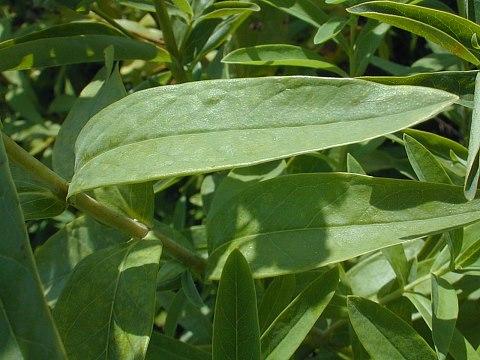
Comments: This species has large attractive flowers and foliage. Unfortunately, the blooming period is relatively short. Giant St. John's Wort is easy to identify because of its large size and the presence of 5 styles on its flowers and seed capsules. Other large Hypericum spp. are usually woody, rather than herbaceous, and they usually have only 1-3 styles. An exception is the woody Hypericum kalmianum (Kalm's St. John's Wort), which also has 5 styles. This latter species has smaller flowers, more narrow leaves, and a shorter and more branched habit of growth than Giant St. John's Wort. Some taxonomists consider North American populations of Giant St. John's Wort to be distinct from the Eurasian populations, and refer to this species as Hypericum pyramidatum. Another common name of this species is Great St. John's Wort.
The central stem and lateral upper stems (if any) terminate in cymes of 1-5 flowers. Relative to the size of the flowers, branches of each cyme are rather short. Each flower is about 2" across, consisting of 5 yellow petals, 5 green sepals, numerous yellow stamens (about 100), and a light green pistil with 5 persistent styles. The petals are widely spreading and often rather floppy or contorted; they may develop streaks of white with age. The sepals are lanceolate-ovate and much shorter than the petals. The blooming period occurs during mid-summer and lasts about 2-3 weeks. Each flower is replaced by a large hairless seed capsule up to 1¼" long and ½" across. Each seed capsule is divided into 5 cells; each cell containsDistribution Map numerous small seeds that are narrowly oblongoid, flattened, and black at maturity. The root system is rhizomatous, often forming small colonies of plants.
Cultivation: The preference is full sun to light shade and moist conditions. This wildflower adapts to different kinds of soil, including loam, clay-loam, and rocky soil. It is robust and easy to grow.
Range & Habitat: The native Giant St. John's Wort is occasional in northern and west-central Illinois; it is rare or absent elsewhere in the state. Illinois lies along the southern range limit of this species in North America; it also occurs in Eurasia. Habitats are rather variable, but they include woodland openings, wooded slopes, banks of rivers and streams, moist thickets and meadows, river-bottom prairies, and fens. This species is usually found in high quality habitats. It is sometimes cultivated in gardens.
Faunal Associations: The flowers are pollinated primarily by bumblebees, which collect pollen. Smaller bees and other insects may visit the flowers as well, but they are less effective pollinators. Only pollen is available as a reward to floral visitors. Some insects feed on the leaves, flowers, and other parts of this and other Hypericum spp. (St. John's Wort species). These include the caterpillars of the moths Eupithecia miserulata (Common Pug), Melanchra assimilis (Black Arches), Synchlora aerata (Wavy-Lined Emerald), Hyppa xylinodes (Common Hyppa), Nedra ramosula (Gray Half-Spot), and Agonopterix hyperella (Oecophorid Moth sp.). The caterpillars of the butterfly Strymon melinus (Gray Hairstreak) feed on the developing capsules and seeds. Other insects that feed on Hypericum spp. include the aphid Brachysiphum hyperici, and the leaf beetles Pachybrachis relictus and Paria sellata. The foliage is somewhat toxic to mammalian herbivores and usually avoided because it can cause irritation of the gastrointestinal tract. The foliage can also cause a harmful reaction to sunlight in light-skinned animals (e.g., pigs), causing irritation of the skin.
Photographic Location: A restored prairie at Meadowbrook Park in Urbana, Illinois.

Comments: This species has large attractive flowers and foliage. Unfortunately, the blooming period is relatively short. Giant St. John's Wort is easy to identify because of its large size and the presence of 5 styles on its flowers and seed capsules. Other large Hypericum spp. are usually woody, rather than herbaceous, and they usually have only 1-3 styles. An exception is the woody Hypericum kalmianum (Kalm's St. John's Wort), which also has 5 styles. This latter species has smaller flowers, more narrow leaves, and a shorter and more branched habit of growth than Giant St. John's Wort. Some taxonomists consider North American populations of Giant St. John's Wort to be distinct from the Eurasian populations, and refer to this species as Hypericum pyramidatum. Another common name of this species is Great St. John's Wort.
0
0





